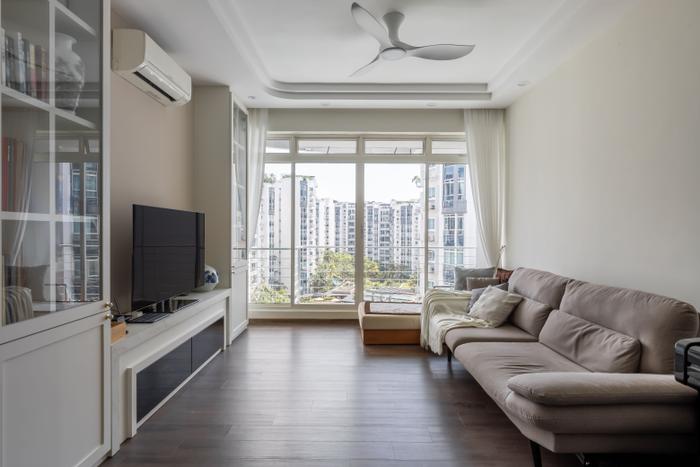Unintentional ‘sauna’ vibes no more.
In Singapore, humidity is a year-round issue. Not just during hot months, but also during the monsoon season, when lower temperatures and high moisture content in the air prevent water from evaporating as quickly.

View this project by Flo Design
And while moisture is good for your skin, too much of it in the air can cause the following problems:
- Clammy air or an unpleasant, musty odour
- Mould, mildew and dust mite growth that can cause respiratory problems
- Insects (e.g. spiders, drain flies and silverfish)
- Laundry taking a long time to dry
- Deterioration of wood-based flooring and furniture
- Cracks/damage to dry walls
- Moisture build-up in the crevices of electronics, leading to damage
- Wear and tear or discolouration of collectibles (e.g. books, leather bags etc.)
If you experience any of these problems at home, your home could be too humid! Here are a few things you can do to mitigate the issue and create a more comfortable indoor environment.
1. Invest in dehumidifying tools

View this project by W Concept
Ideally, indoor humidity levels should be between 40% to 50%. For a small area like a cabinet or wardrobe, a disposable dehumidifier or charcoal sachets can help remove excess moisture and prevent mould and mildew.
If you need to cover a large area, getting a dehumidifier machine is a no-brainer. However, be sure to check that the water tank's capacity is large enough for your property before investing in one.
2. Ventilate your home

View this project by Le Interior Affairs
One of the most effective ways to combat high humidity levels in your home is to make sure it is well-ventilated.
The ideal layout for a well-ventilated home is one that possesses windows and doors on opposite sides of the unit, which allows cross-ventilation to take place.
But even if your home does not have such a layout, opening your windows (if it’s not raining, of course) and/or doors as much as possible will still allow air from the outside to enter, replacing the trapped air inside.
3. Tweak your air-conditioning settings

View this project by Inizio Atelier
Turning on your air conditioning not only cools down the room but also helps to reduce indoor humidity by replacing warm, humid air with cool, dry air.
We recommend turning your A/C to the Dry Mode (which is available in most air-conditioning units) and frequently washing/changing any filters to keep them in optimal working condition.
4. Install ceiling and exhaust fans in your home
Cooking and showering are the biggest culprits in causing indoor humidity levels to rise, and that’s because the heat and steam from boiling water or hot showers contribute extra moisture into the air.

View this project by Seiji Interior
Installing a corner fan in your kitchen and bathroom can help to disperse this excess moisture, making cooking or coming out of a hot shower a more enjoyable, sweat-free experience.

View this project by Thom Signature Design
Alternatively, consider installing exhaust fans or built-in ventilators in the kitchen and bathroom. They help keep your spaces dry, and even remove odours in the process.
5. Make some lifestyle changes

View this project by WK Design Space
If you’re one to take hot showers, consider lowering the water temperature by just a few degrees so there’s less steam generated.
If you have a shower screen, use a squeegee to remove excess water from your glass doors, walls and tiles. Remember to direct the excess water towards your bathroom floor trap and ensure that the water is properly drained.
6. Grow some indoor plants

View this project by Darwin Interior
Plant parents rejoice! Introducing certain types of houseplants into your space not only helps to reduce moisture levels, they also make your home look great.
Plants such as Boston ferns, Aloe Vera, and Ficus trees absorb excess moisture in the air, on top of improving your indoor air quality.
This article was first published on 18 March 2021 and last updated on 25 November 2025.

 Get a budget estimate before meeting IDs
Get a budget estimate before meeting IDs